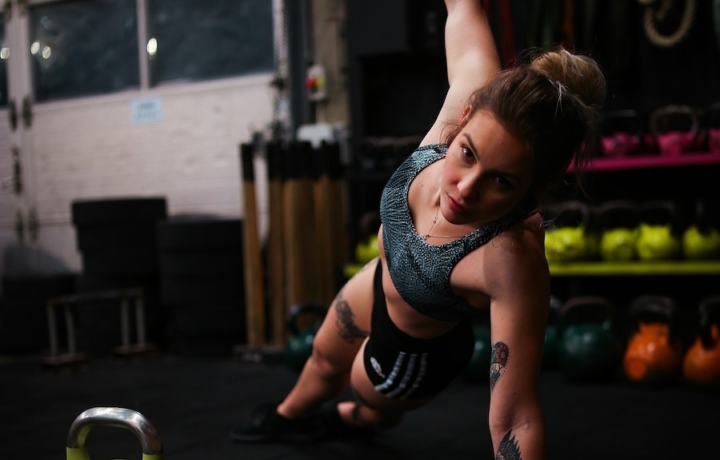Exercise
Dead Bug

Dead Bug
How to Perform
- Lie flat on your back with your arms extended toward the ceiling and your legs raised with knees bent at 90 degrees.
- Press your lower back firmly into the floor by engaging your core and slightly tucking your pelvis.
- Exhale as you slowly lower your right arm behind your head and extend your left leg away from your body, keeping both a few inches off the floor.
- Maintain a neutral spine throughout the movement by keeping your lower back pressed into the floor.
- Inhale as you return your arm and leg to the starting position with control.
- Repeat the movement with the opposite arm and leg, extending your left arm behind your head and your right leg away from your body.
- Move at a controlled pace, focusing on stability rather than speed or range of motion.
- Continue alternating sides, breathing rhythmically and ensuring your core remains engaged throughout.
Important information
- If you feel your lower back arching off the floor, reduce the range of motion or keep one foot on the floor to maintain proper form.
- Keep your head and shoulders relaxed on the floor throughout the exercise to avoid neck strain.
- Progress gradually by first mastering the movement with one limb at a time before attempting contralateral (opposite arm/leg) movements.
- Focus on quality over quantity – slower, controlled movements with proper form are more effective than rushing through repetitions.

Dead Bug
Exercise Details
Primary Muscles
Muscle Groups
Mechanic
Built for progress
Take the guesswork out of training
Create personalized AI-powered workout plans that evolve with you. Train smarter, track every rep and keep moving forward, one workout at a time.






The Dead Bug exercise stands as a cornerstone of core training, offering tremendous benefits with minimal equipment needs. This deceptively simple movement targets the deep abdominal muscles, particularly the transverse abdominis, while simultaneously engaging the entire core complex. As a beginner-friendly exercise, the Dead Bug provides an accessible entry point for those new to fitness while still delivering substantial results for more experienced individuals.
What makes the Dead Bug particularly valuable is its ability to strengthen the core while maintaining a neutral spine position. This makes it exceptionally effective for those recovering from back injuries or looking to build foundational strength without compromising spinal health. The controlled nature of the movement allows for precise muscle activation, helping to establish the mind-muscle connection so crucial for effective abdominal training.
Perfect for warm-up routines, the Dead Bug primes your core for more demanding exercises by activating the stabilizing muscles that protect your spine during movement. Similarly, incorporating this exercise into your cool-down can reinforce proper movement patterns and core engagement when the body is already warmed up, potentially enhancing neuromuscular learning.
During recovery phases of training, the Dead Bug serves as an ideal low-impact option that maintains core strength without overtaxing the nervous system. The exercise's focus on contralateral limb movement—opposing arm and leg coordination—also makes it valuable for improving functional movement patterns that translate to everyday activities and sports performance.
Perhaps most importantly, the Dead Bug excels at training anti-extension, teaching your body to resist arching the lower back—a skill crucial for both athletic performance and injury prevention. As you progress in your fitness journey, this fundamental exercise can be modified in countless ways to continue challenging your core stability, making it a timeless addition to any comprehensive fitness program.
FAQ - Dead Bug
The Dead Bug primarily targets the deep core muscles, especially the transverse abdominis and rectus abdominis, while also engaging the obliques and lower back. The movement also requires coordination from the hip flexors and shoulder stabilizers as you extend your limbs.
For an easier version, keep your knees bent at 90° while moving your limbs, or move just one limb at a time. To increase difficulty, add resistance bands, hold light weights in your hands, or extend the time under tension by slowing down each repetition and adding isometric holds.
The most common mistake is allowing your lower back to arch off the floor, which compromises core engagement and can strain your spine. Other errors include moving too quickly, lifting your head excessively, and not maintaining constant pressure between your lower back and the floor throughout the movement.
Yes, when performed correctly, the Dead Bug is generally considered safe and beneficial for those with back issues because it strengthens core muscles while maintaining a neutral spine position. The exercise actually teaches proper spinal positioning and can be part of rehabilitation programs, though individuals with specific conditions should consult their healthcare provider first.
Dead Bugs can safely be performed 3-4 times per week as part of your core training regimen. They work well as a warm-up exercise before more intense training or as part of a dedicated core circuit, with 2-3 sets of 8-12 repetitions per side being optimal for most fitness goals.







